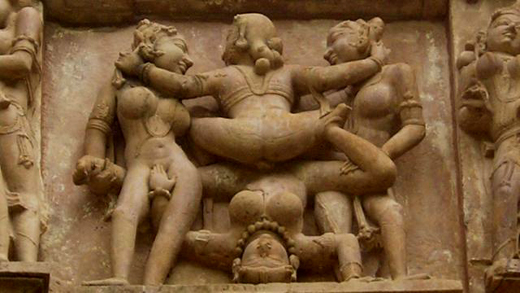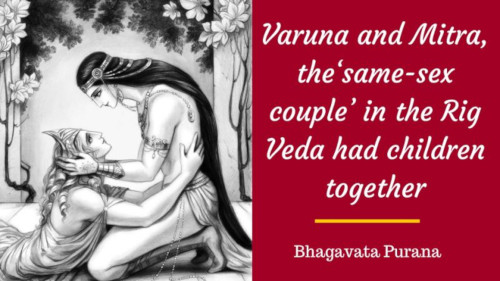Indian Culture Does Recognise Homosexuality, Let Us Count the Ways
Indian Culture Does Recognise Homosexuality, Let Us Count the Ways
www.mangaloretoday.com
No sooner did the Supreme Court deliver the landmark judgment against Section 377, Rashtriya Swayamsevak Sangh (RSS) leader Arun Kumar uttered the word – “unnatural”.He told the media:

"Gay marriage and relationship are not compatible with nature and are not natural, so we do not support this kind of relationship. Traditionally, India’s society also does not recognize such relations."
As usual, other members of right-wing factions joined the chorus – stubbornly maintaining that homosexuality is against nature.
But are we sure about that? Can we honestly say that it was never "recognized"? Here’s a little history lesson, one that people like Mr Kumar should already have been familiar with as the self-appointed guardians of Hindu culture.
Surprise, the Vedic System Recognised Homosexual Unions!

Amara Das Wilhelm’s book "Tritiya-Prakriti: People of the Third Sex", compiles years of extensive research of Sanskrit texts from medieval and ancient India, and proves that homosexuals and the "third gender" were not only in existence in Indian society back then, but that these identities were also widely accepted.
Citing from the chapter "Purushayita" in the Kama Sutra, a 2nd century ancient Indian Hindu text, the book mentions that lesbians were called "swarinis". These women often married other women and raised children together. They were also readily accepted both within the ’third gender’ community and ordinary society.
The book further made mention of gay men or "klibas", which though could refer to impotent men, represented mostly men who were impotent with women due to their "homosexual tendencies".
The Kama Sutra’s homosexual man could either be effeminate or masculine. While they were known to be involved in relationships of a frivolous nature, they were also known to marry each other. The book further mentions that there were eight different kinds of marriages that existed under the Vedic system, and out of those, a homosexual marriage between two gay men or two lesbians were classified under the "Gandharva" or celestial variety – "a union of love and cohabitation, without the need for parental approval".
Who Can Deny Khajuraho?
It’s impossible to talk about homosexuality in ancient India without referring to one of its most affirmative and visual ‘proofs’, so to speak. The sculptures in the Khajuraho temple of Madhya Pradesh are known for their overt homosexual imagery. The temple is popularly believed to have been built sometime around the 12th century.
The sculptures embedded in the Khajuraho temple depict what seem to be sexual fluidity between man and man and woman and woman. There are even instances of all-female orgies.
While the sculptures also depict “accepted” sexual relations between male and female entities, it is well-known for showcasing the existence of intimacy between members of the same sex.
Upon his visit to the temple, US-based techie Hrishikesh Sathawane wrote in DNA:
“If you think homosexuality is a western concept, go to Khajuraho... It is debatable if these things were socially acceptable in India, but they existed.”
Bhagirathi – The King Born of Two Queens

According to Krittivasi Ramayan, composed by 15th century Bengali poet Krittibas Ojha, King Sagara of Ayodhya was desperate to maintain his bloodline after losing most of his sons to Kapila sage’s wrath.
The threat to the dynasty further worsened, when Dilip, his only heir, died before he could give his two queens the magic potion that would make them pregnant. But according to the poem, the widows drank the potion and made love to each other to conceive a child, with one of them becoming pregnant.
The child was none of other than King Bhagirathi, who is known in mythology for bringing the Ganges down to earth from the heavens.
Varuna and Mitra

Varuna and Mitra, famously referred to as the “same-sex couple” in the ancient Indian scripture of the Rig Veda, were often depicted riding a shark or crocodile or sitting side-by-side on a golden chariot together.
According to the Shatapatha Brahmana, a prose text describing Vedic rituals, history and mythology, they are representatives of the two half-moons.
According to the Bhagavata Purana, Varuna and Mitra also had children. Varuna fathered his first son when his semen fell upon a termite mound. They had two other sons, Agastya and Vasistha, who were born from water pots after Mitra and Varuna discharged their semen in the presence of Urvasi.
Even Rakshasas in the Ramayana

Now, who can turn a blind eye to the Ramayana? Valmiki’s famous epic, written somewhere between the 5th and 6th centuries, also mentions homosexuality.
Now, this puts the right-wing ideology in a bit of a pickle. Remember when Culture Minister and BJP Leader, Mahesh Sharma, said: “I worship Ramayana and I think it is a historical document. People who think it is fiction are absolutely wrong”?
If it isn’t fiction, according to the BJP leader, and it also makes mention of homosexuality, then isn’t the position that ‘Indian culture doesn’t recognise homosexuality’ a little... contradictory?
Valmiki’s Ramayana depicts Hanuman witnessing Rakshasa women kissing and embracing those women who had been kissed and embraced by Ravana. This is a clear acknowledgement of same-sex intimacy in India history and tradition.
To sum up, if we go by these popular references in Indian history and mythology, then it appears that ancient “Indian society” did indeed “recognize” homosexuality through that period, and in many cases, even accepted it.
So, isn’t it just factually incorrect to deny that homosexuality has been part of Indian tradition?
Courtesy: The quint
Read other news
- Mouni Roy picks a pretty pastel pink schiffli skirt set
- ’Gift of God’: Athiya Shetty, K L Rahul rev
- Disha Patani turns up the heat in a bold orange saree a
- Mouni Roy exudes traditional elegance in a black and go
- Preity Zinta’s smokey glam and voluminous waves s
- Kriti Sanon, Rashmika Mandanna, and others make a styli
- Janhvi Kapoor turns heads in a sage green corset and sa
- A Comprehensive Guide to Navigating the Official Telegr
- Keerthy Suresh walks the festive path stylishly in a bl
- Wondering How a 15-Lead ECG Enhances Cardiac Diagnosis?
- J&K terror attack: India seems to be building its case for striking Pakistan
- Pakistan violates LoC ceasefire for third consecutive night
- Bengaluru: ED arrests woman who ’cheated’ people, claimed ’proximity’ with politicians
- 280 injured, several feared dead after explosion tears through Iran’s Bandar Abbas port
- Two ATM robbers shot at in Kalaburagi
- Blood will flow if India stops river water, Bilawal Bhutto threatens
- Not a drop of water to Pakistan, says Jal Shakti Minister
- Ranya Rao charged under anti-smuggling law, to be detained for year: Sources
- Houses of 5 terrorists across J&K razed days after Pahalgam attack
- Strong message from UN Security Council after Pahalgam terror attack
- Pakistan continues unprovoked firing along LoC; Indian Army responds
- Kashmir on high alert after intel warns of terror plots targeting non-locals, rail network
- Tenants struggle to avail Gruha Jyothi Scheme benefits due to multiple Aadhaar linkages with AEH meters
- IT Centre of KEONICS in Mangaluru expected to be ready in two-and-half years
- Om Prakash murder: Former Dy.SP Anupama Shenoy suspects role of PFI
- Pope Francis laid to rest. Humble funeral draws world leaders, massive crowds
- Two booked for abusing, misbehaving with doctor on duty at hospital in Puttur
- Udupi-Bengaluru private bus catches fire in Mandya; passengers safe
- Vittal: Decomposed body of Paltaje resident found in isolated spot
- We are in favor of peace, Union Govt must strengthen security measures says Siddaramaiah
- 3 Pak women residing in City Police Commissionerate limits
- All-religion meet pays homage to late Pope Francis
- Pahalgam attack: DK Congress holds candle light vigil
- Tirthahalli student Deeksha scores 600/600 in II PU after revaluation, tops science stream in Karnataka
- Kudremukh trekking circuits to reopen from May 1
- CITY INFORMATION
- TRAVEL
- TOURIST INFORMATION
- HEALTH CARE
- MISCELLANEOUS






 Write Comment
Write Comment E-Mail To a Friend
E-Mail To a Friend Facebook
Facebook Twitter
Twitter  Print
Print 


